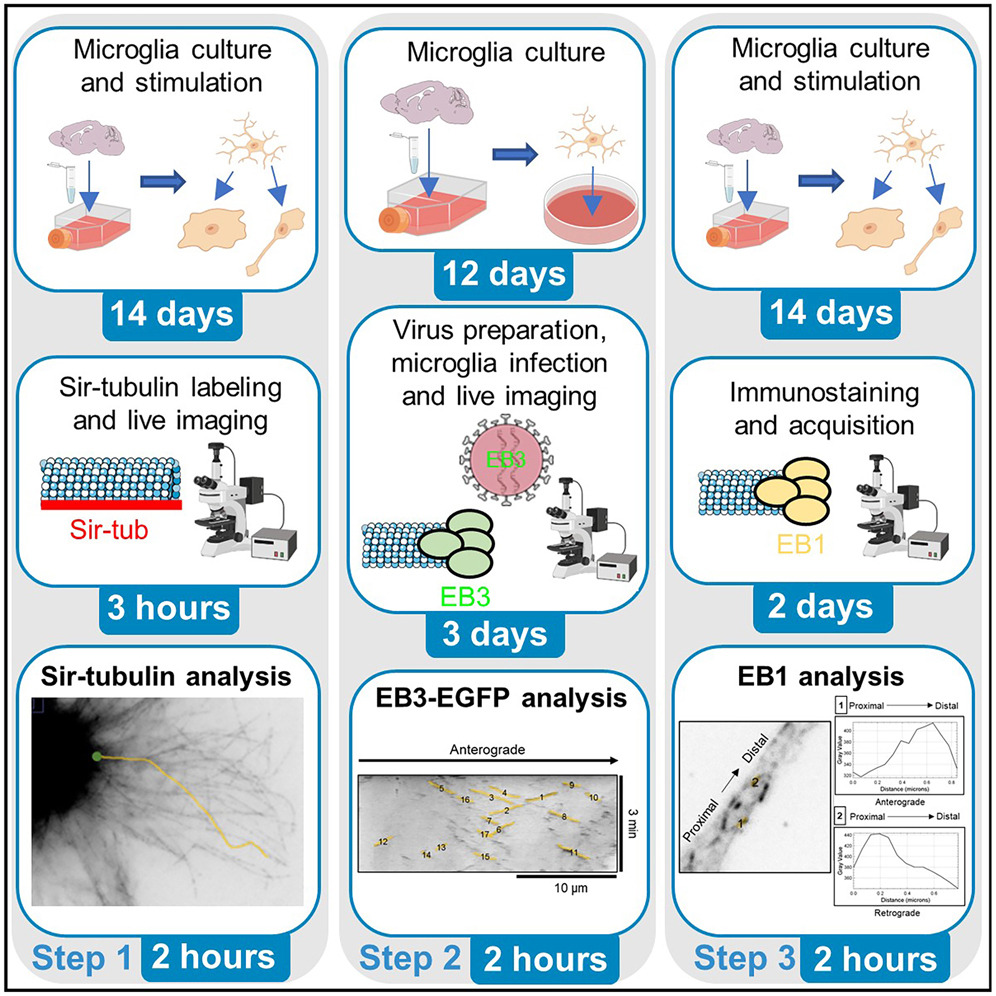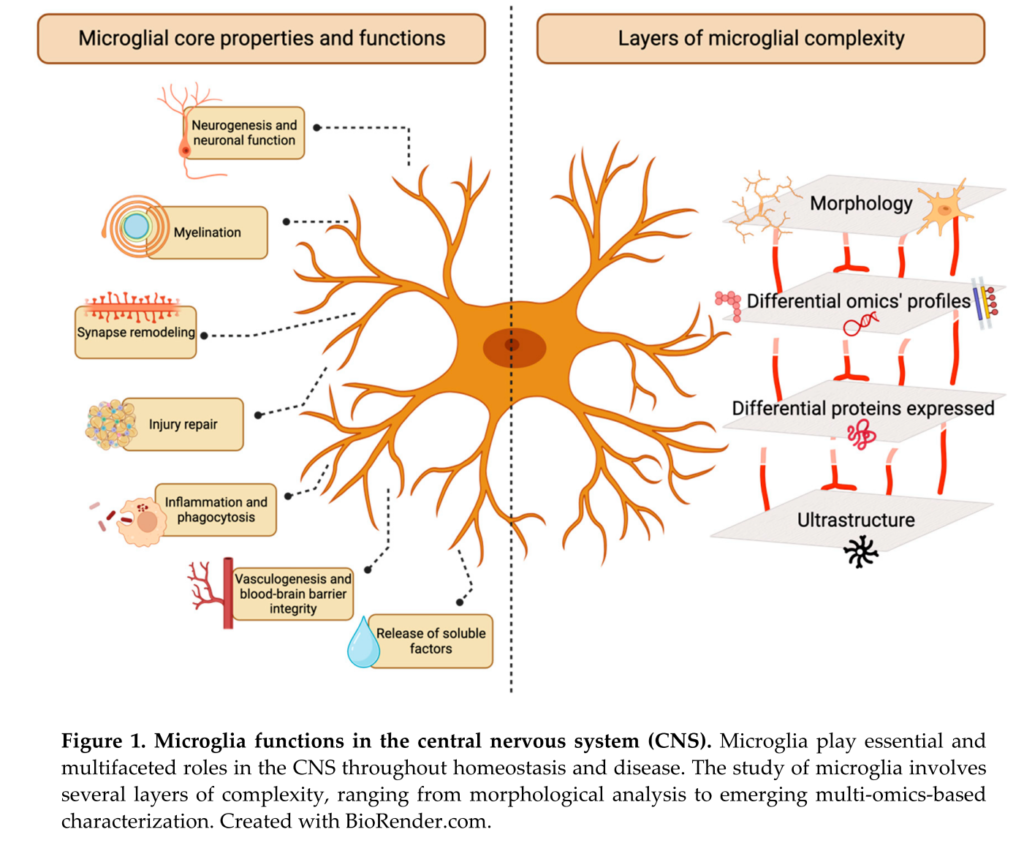本日は、医学類の学生がプログレスレポートを、大学院生がジャーナルクラブを行いました。研究室では、ニューロサイエンス学位プログラムの神経科学実験実習が進行中です。まだまだ暑いですが、涼しくなった秋は研究の更なる加速を行いたいところです。
Cell Reports ARTICLE| VOLUME 42, ISSUE 2, 112104, FEBRUARY 28, 2023
Microglia reactivity entails microtubule remodeling from acentrosomal to centrosomal arrays (ミクログリア活性化には、無中心体から中心体への微小管リモデリングが関与している)
Published: February 13, 2023 DOI:https://doi.org/10.1016/j.celrep.2023.112104
STAR Protocol Volume 4, Issue 3, 15 September 2023, 102499
Protocol for observing microtubules and microtubule ends in both fixed and live primary microglia cells (初代ミクログリア細胞を固定およびライブで微小管および微小管末端を観察するためのプロトコール)
Caterina Sanchini 15, Maria Rosito 12, Alessandro Comincini 3, Simone De Panfilis 1, Francesca Bartolini 3, Silvia Di Angelantonio 1246
Highlight
恒常性ミクログリアと反応性ミクログリアにおける微小管ダイナミクスの解析
恒常性ミクログリアにおける微小管プラス端の動態と配向の解析
EB蛍光勾配:固定細胞における微小管配向を決定するツール
まとめ
微小管の動態と配向は、多くの重要な細胞プロセスにおいて重要な役割を担っている。しかしながら、初代ミクログリアにおける微小管および/または微小管末端の機能的ライブイメージングは困難である。ここでは、固定した初代ミクログリア細胞と生きた初代ミクログリア細胞の両方で微小管と微小管末端を観察するためのプロトコールを紹介する。ミクログリアの培養とin vitro刺激、SiR-チューブリン標識、レンチウイルスの調製、ライブイメージング、免疫染色、画像取得の手順について述べる。また、SiR-チューブリン、EB3-EGFP、EB1解析の手順についても述べる。

Preprint Review
Emerging Techniques for the Study of Microglia: Visualization, Depletion and Fate Mapping (ミクログリア研究のための新しい技術: 可視化・除去・運命マッピング)
Bianca Bobotis , Torin Halvorson , Micaël Carrier , Marie-Ève Tremblay *
Abstract
The central nervous system (CNS) is an essential hub for neuronal communication. As a major component of the CNS, glial cells are vital in the maintenance and regulation of neuronal network dynamics. Research on microglia, the resident innate immune cells of the CNS, has advanced considerably in recent years, and our understanding of their diverse functions continues to grow. Microglia play critical roles in the formation and regulation of neuronal synapses, myelination, responses to injury, neurogenesis, inflammation and many other physiological processes. In parallel with advances in microglial biology, cutting-edge techniques for the characterization of microglial properties have emerged with increasing depth and precision. Labeling tools and reporter models are important for the study of microglial morphology, ultrastructure and dynamics, but also for microglial isolation, which is required to glean key phenotypic information through single-cell transcriptomics and other emerging approaches. Strategies for selective microglial depletion and modulation can provide novel insights into microglia-targeted treatment strategies in models of neuropsychiatric and neurodegenerative conditions, cancer and autoimmunity. Finally, fate mapping has emerged as an important tool to answer fundamental questions about microglial biology, including their origin, migration and proliferation throughout the lifetime of an organism. This review aims to provide a comprehensive discussion of these emerging techniques, with applications to the study of microglia in development, homeostasis and CNS pathologies.
中枢神経系(CNS)は、神経細胞のコミュニケーションに不可欠なハブである。CNSの主要な構成要素として、グリア細胞は神経細胞ネットワークの動態の維持と制御に不可欠である。CNSに常在する自然免疫細胞であるミクログリアに関する研究は近年大きく進展し、その多様な機能についての理解は深まりつつある。ミクログリアは、神経シナプスの形成と制御、髄鞘形成、傷害に対する応答、神経新生、炎症、その他多くの生理学的プロセスにおいて重要な役割を果たしている。ミクログリア生物学の進展と並行して、ミクログリアの特性を評価するための最先端の技術が、より深く、より正確に出現してきている。標識ツールやレポーターモデルはミクログリアの形態、超微細構造、動態の研究に重要であるが、ミクログリアの単離にも重要であり、シングルセル・トランスクリプトミクスやその他の新たなアプローチを通して重要な表現型情報を得るために必要である。選択的なミクログリアの除去と調節のための戦略は、精神神経疾患や神経変性疾患、がん、自己免疫のモデルにおいて、ミクログリアを標的とした治療戦略に新たな知見を与えることができる。最後に、宿命マッピングは、生体の生涯を通じてのミクログリアの起源、移動、増殖など、ミクログリアの生物学に関する基本的な疑問に答える重要なツールとして浮上してきた。本総説は、発生、恒常性維持、中枢神経系病態におけるミクログリアの研究への応用を念頭に、これらの新たな技術について包括的な議論を提供することを目的としている。


